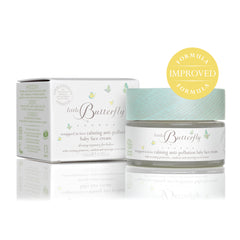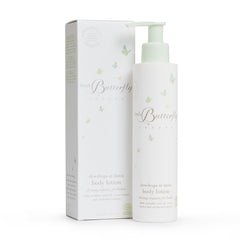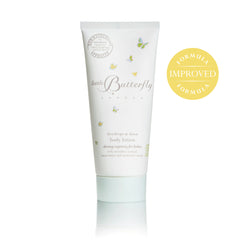The Definitive Guide To Stretch Marks & Stretch Mark Creams
What results will a stretch mark cream give you?
Stretch marks cause a lot of us concern and although a normal occurrence in many people, most would rather they not appear at any life stage.
There are numerous products on the market claiming to prevent or reduce the appearance of stretch marks so let’s take a look into the what, the why, and the how when it comes to changes in your skin, particularly during pregnancy.

Definition of stretch marks
Appearing as streaks or lines on the skin's surface layer, stretch marks appear as the name suggests, when the skin stretches. Obviously, your skin has the ability to stretch to a degree but when the body undergoes rapid growing or shrinking the connective tissues can be damaged thus causing initially raised dark streaks (depending on your skin tone).
Over time, stretch marks tend to lighten and fade, in some skin types taking on an almost silvery hue.

Misconceptions about stretch marks
Anyone can get stretch marks, men and women of any body size, stretch marks are often associated with pregnancy but other causes include puberty, weight gain/loss, certain medical conditions, and even muscle building.
Genetic factors can cause an individual to be ‘prone’ to stretch marks, for example, in pregnancy one person may experience a lot of stretch marks, particularly around the tummy, hips, thighs, buttocks, and breasts due to the rapid changes the body experiences in pregnancy and yet another pregnant individual may not experience any skin changes at all.
Stretch marks cannot be prevented and are a natural occurrence and very common. Whilst you can moisturise and hydrate the skin and reduce the appearance of stretch marks there is no magic cure to prevent them altogether. Any brand stating a miracle cure should be avoided.
So what exactly causes stretch marks?
This article focuses on stretch marks and the pregnant woman, according to the NHS stretch marks affect 8 out of 10 pregnant women. Stretch marks can appear at any stage of pregnancy and sometimes itching is a tell-tale sign you may be affected. They are harmless and cause no health concerns however many women would like to prevent or reduce the appearance of stretch marks.
When the skin is stretched rapidly with the weight gain associated with pregnancy, the skin's middle layer, the dermis is damaged.
The skin is made up of two layers, the dermis and the epidermis.
Stretch marks occur at the deeper layer, so any treatment needs to bear this in mind, they are not on the skin's surface.

What happens to the skin during pregnancy?
Pregnancy can bring many changes to the skin's structure, factors such as hormonal changes and rapid growth to accommodate a growing baby mean each individual may experience hyperpigmentation, acne, oily skin, vascular changes, skin sensitivity and stretching.
Pregnancy and hyperpigmentation
Changes in skin colour during pregnancy are caused by hormonal and genetic factors, this is known as hyperpigmentation. Darker areas around the areola and abdomen for example are very common (known as linea nigra) and often fade after pregnancy.
Melasma is the term used to describe changes in pigmentation on the face, commonly appearing across the forehead, upper lip, nose and cheeks.
It is believed to be caused by the increase of melanin, due specifically to the oestrogen and progesterone rise during pregnancy.
Pregnancy and acne/oily skin
Pregnancy acne is caused by hormonal fluctuations stimulating the skin's sebaceous glands producing more sebum (oil) than necessary. This can lead to you experiencing more oilier than normal skin and clogged pores, in turn leading to ‘hormonal acne’.
Pregnancy and vascular changes
As the body grows and the uterus expands during pregnancy, the blood vessels are under more strain than usual. Increased pressure, especially on the legs can cause varicose veins. Spider vein appearance is also common during pregnancy.
Pregnancy and skin sensitivity
Hormonal changes can see your skin being more sensitive than usual and rashes, itching and even dry skin are all common symptoms. If concerned, seek medical advice, particularly if an allergic reaction is suspected, even products tried and tested pre-pregnancy can be unsuitable during this phase. Each individual's sensitivity varies.
Pregnancy and stretch marks
Stretch marks (striae gravidarum) can appear during pregnancy due to the rapid physiological changes that occur at this special time.
The skin's elasticity derives from collagen and elastin fibres, fluctuations in oestrogen, cortisol and relaxin impair these fibres.
The dermal layer, when rapid growth is experienced, can be stretched beyond normal limits thus causing the appearance of stretch marks.
As the body tries to repair the connective fibres of the skin via an inflammatory response, this in turn can affect collagen synthesis further creating stretch marks.
Genetic factors can account for one's susceptibility to developing stretch marks, due to a predisposition to produce less collagen and elastin.
Prevention
What is the best thing to put on stretch marks?
There are many myths and misconceptions about what works best to reduce or prevent stretch marks and popular home remedies shared from generation to generation.
These include a regular cocoa butter lotion and over-the-counter oils.
What ingredients make a good stretch mark cream?
There are many ingredients that need to be present in a stretch mark cream to make it a good one, below is the list of ingredients in our own stretch mark cream.
Little Butterfly London Stretch Mark Butter ingredients:

Cupuaçu
The national fruit of Brazil, the benefits of Cupuaçu, include high antioxidant properties and the ability to moisturise and hydrate skin. It is related to the cacao tree, another property we use in our stretch mark butter.
Kokum
Another hydrating butter, the seed oil of the kokum tree is a less-known plant butter effective in moisturising the skin and is found in tropical regions. A great addition to our stretch mark butter blend.
Mango
An antioxidant-rich fruit which promotes collagen production, rich in vitamin C and moisture retaining.
Illipe
A plant native to Indonesia and Malaysia, the Illipe nut extract has amazing moisturising properties and is known to restore skin elasticity.
Cacao
The benefits of cacao used in skincare products are vast. Benefits include its powerful antioxidants; flavonoids and polyphenols.
Extracted from the beans of the cacao tree, with amazing emollient properties, this ingredient in our stretch mark butter helps to retain moisture and helps dry or rough skin feel smooth and supple.
Improving blood flow and circulation, resulting in a radiant, healthy complexion, cacao is uplifting and indulgent, a crucial element in our unique butter blend.
Shea
Offering deep moisturisation and nourishment, shea butter (derived from the Shea Tree nut) has many benefits as a skincare ingredient. Rich in vitamins A, E and F, Shea also acts as a protective barrier shielding the skin from external stressors in the environment.
Anti-inflammatory properties calm and soothe the skin and shea has worked to good effect in dry skin conditions such as eczema and dermatitis.
With the ability to neutralise free radicals, Shea is an excellent addition to our stretch mark butter blend.
ElestanTM from the leaf of Manilkara
Improving skin tone and protecting elastin and collagen, the manilkara leaf extract is an excellent component in our stretch mark cream formula and is associated with anti-ageing, inhibiting collage glycation, an ageing process where collagen loses its elasticity.
ArganylTM from the leaves of the argan tree
Argan oil is associated with skin healing, moisturisation and brightening skin in need of hydration. Usually extracted from the kernels, we include ArganylTM from the leaves of the argan tree into our stretch mark cream formula.
Native to Morocco, offering anti-inflammatory, antioxidant protection and anti-ageing effects, as well as promoting a healthy skin barrier and aid in wound healing, a vital element to our stretch mark cream formula.
Sea algae extract
Supporting skin hydration and elasticity, sea algae is also found to help surrounding hyperpigmentation. With anti-inflammatory properties, this peptide-rich extract can also increase collagen production.
Rooibos
With a high flavonoid content (plant-derived compounds associated with anti-inflammatory and antioxidant properties) rooibos is a fantastic addition to neutralise free radicals and protect cells from oxidative stress.
Arnica flower
Well known for its soothing properties, arnica is a herb from the sunflower family. An anti-inflammatory, antiseptic and analgesic, arnica is associated with wound healing and the ability to stimulate blood flow and white blood cells (the body’s natural defence).
What are antioxidants
Combating free radicals, antioxidants are naturally found in the body, however, you can increase your intake of antioxidants orally and topically.
Antioxidants include vitamins C and E.
What are free radicals?
On a cellular level, free radicals can damage cells and are linked to disease and ageing.
Factors, where oxidation can occur, include stress, injury, pollution, poor diet, infection and ageing.
To conclude, this is why antioxidants are so important to counteract the effects of free radicals.
Do stretch mark creams actually work?
Stretch mark creams, similar to other skincare routines, improve skin health and also depending on the product help reduce the appearance of stretch marks.
Finding a good stretch mark cream which works for you improves your confidence and helps with the acceptance of skin changes which might cause concern.
Here is what some of our stretch mark butter users have to say about cocoon of bliss stretch mark butter
"So good I had to write this review!
After my second baby, and nearly a 20 year age gap between babies, I cannot believe how effective this product has been. It was purchased for me by a friend in a gift set, I can honestly say it is amazing (great friend...lol). Being nearly 40, and skin elasticity not being what it was when I was 20, I am pleasantly surprised with the end results. Very little difference to my older stretch marks. Im not lucky enough to be a naturally slim being, and my weight has always gone up and down but I will continue to use this product despite not being pregnant. Massive thumbs up"
"My favourite cream for belly"
"The best I’ve found on the market"
"Soothes my skin"
"I was worried I would get marks, so started using this literally on day 1 as recommended by Little Butterfly. Now week 32 still and no marks yet, it also helped immensely with the terrible itchiness I felt in the beginning. It seems to leave my skin much more resilient and overall deeply nourished and hydrated."
Can stretch marks be removed?
Whilst stretch marks cannot be physically removed it may be worth talking to a dermatologist or other skin care professional to discuss your options surrounding reducing their appearance.
Treatment options such as laser therapy, microdermabrasion and ultrasound are available to explore and discuss with a dermatologist.
Trying stretch mark creams can give good results, especially over time so it is worth testing a topical product for a while and seeing if you experience improvements before opting for cosmetic procedures.
However, here are what some treatments offer, just bear in mind individual results vary…
Laser therapy
Laser therapy works by using targeted laser energy to stimulate a healing response in the skin by creating tiny injuries to the underlying skin caused by a fractional laser device, this method is called fractional laser resurfacing.
As discussed, collagen and elastin fibres in the skin are crucial for skin elasticity and structure, therefore laser therapy targets the under layers of the skin (the dermis) where stretch marks happen, by stimulating the production of new collagen and elastin fibres.
New collagen replaces damaged skin tissue and makes it possible to fill and smooth the stretch marks, this is not a guaranteed simple process but in terms of hyperpigmentation, in the case of very dark or noticeable stretch marks for example, laser therapy may be an option to explore when treating stretch marks.
Microdermabrasion
Microdermabrasion is another method offered in the treatment surrounding stretch mark appearance improvement. Exfoliation by way of fine crystal therapy, is used to remove a layer of dead skin gently, thus improving the appearance of the skin's surface. Collagen production is once again increased, and it is believed skin absorbency improves post dermabrasion treatment. This creates a better surface for stretch mark creams to be applied. A series of dermabrasion sessions is usually offered, with varying results depending on the client.
Ultrasound
A non-invasive treatment option using high frequency sound, ultrasound therapy for stretch marks works in the following way.
Penetrating the skin's deeper layer, sound waves generate heat, stimulating collagen production. Increasing blood flow, ultrasound can trigger the body to absorb topical treatments better, by a process called sonophoresis, increasing topical product effectiveness.
Microneedling
Tiny needles create micro injuries in the skin, creating a collagen stimulation response. This process also promotes better penetration of topical products and is particularly used as an option for the treatment of newer appearing stretch marks. This treatment is not as effective on older white/greyish stretch marks.
Chemical peel
Chemical solution is applied to the affected areas and exfoliates dead skin, encouraging the regeneration of new skin cells. The depth of the chemical peel is a factor in the effectiveness in reducing the appearance of stretch marks.
PRP therapy
Platelet Rich Plasma therapy is used to treat various skin concerns including the reduction of the appearance of stretch marks. Platelets contain growth factors, crucial in the regeneration of new cell generation and repair.
Small amounts of the patient's blood are withdrawn, and the platelets are separated then applied to the area of concern either topically or injected. Encouraging the body's natural healing and skin repair, PRP therapy works by tightening and smoothing the appearance of stretch marks by encouraging collagen production and tissue regeneration.
All procedures noted do not guarantee desired results and usually a course of sessions would be required, as advised by a dermatologist or skin specialist dependent on the treatment explored.
Factors such as skin tone, age, severity and individual response to treatment can all determine the results. It is better to start with a good quality stretch mark cream over some months before considering more invasive or harsh cosmetic treatments which can give mild to moderate improvements. We would recommend discussing your expectations with your skin specialist before deciding on a cosmetic procedure for stretch marks.
Sharing Experiences With Other Mums

Embracing the changes in your body during pregnancy and the postpartum phase is not always easy but accepting your body is amazing and incorporating skin self-care routines into your schedule can really help celebrate your body and feel good in your skin.
Sharing your experiences with other mums to be or new mums can really help you to feel positive when it comes to your post-pregnancy skin. Some skin conditions in pregnancy are temporary and some we have to accept are a natural part of the motherhood journey.
We asked some mums who developed stretch marks in pregnancy how they feel about them…
‘I hated them to start with, but now they don’t bother me at all. They are there, part of me’ it’s who I am. Mine are also from weight loss and gain, not just pregnancy. My youngest is 1o this year, so they are not red and angry anymore. I don’t really notice them’ - Shelley
‘I had my first child at 19, at first I one hundred percent hated them! Me and my mum have exactly the same tummy marks, it must be genetics! I remember my partner's cousins who both had four children each and never got a single stretch mark!’ - Malibu
‘I was a little nervous when they first showed up, they were deep red, but they faded pretty quickly.’ - Debbie
‘They are a part of my story, they don't bother me. I do have a few client’s who are bothered by them though. Most aren’t, in fact I would say most of my clients are more worried about them in pregnancy rather than further down the line.’ - Hayley
‘They bother me, especially as none of my family got them in pregnancy. I developed them in my first pregnancy and I wish I had used stretch mark cream, although I have no idea whether it would have made a difference or not. I didn’t get many more in my next two pregnancies’ - Leah
So What's Next?
Although stretch marks cannot be prevented completely, staying hydrated, and active through your pregnancy and using a good quality stretch mark cream such as our cocoon of bliss stretch mark butter will all help improve your skin's elasticity and minimise the appearance of stretch marks.
There has been research to suggest properly massaging the affected areas helps absorbency and the results experienced, but of course, every individual's experience varies.
Sadly, one cannot prevent stretch marks however with the best stretch mark cream formula we have created, using cocoon of bliss as part of your skincare routine can really improve how you look and feel about your pregnant or post-pregnancy body.
Treat stretch marks with cocoon of bliss stretch mark butter, and within a few months you should see good improvements in your skin's suppleness and tone. With natural ingredients such as cacao and mango, not only will your skin feel great, our natural formula smells great too.



